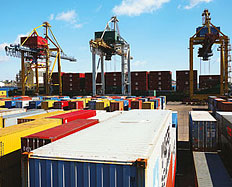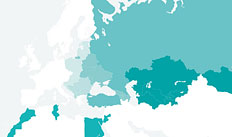Country Assessments
Belarus
HIGHLIGHTS OF THE PAST YEAR
- The economy moved towards stabilisation after a deep balance-of-payments crisis. Following a large exchange rate devaluation, the authorities pursued tighter monetary and fiscal policies and trimmed the large directed lending programme.
- Ambitious privatisation plans were abandoned. The authorities decided to scrap the privatisation lists and instead pursue negotiation of privatisation agreements on a deal-by-deal basis, so far primarily with Russian state enterprises.
- The authorities continued implementing some deregulation reforms. Several measures to simplify access to land, lending to SMEs and reduce red tape were approved.
KEY PRIORITIES FOR 2013
- Establishing a credible policy framework for macroeconomic policy is a key priority. Output and dollar wage targets should be made consistent with the goal of price and external stability, while the central bank should target low inflation and a wage policy consistent with productivity growth.
- The authorities should utilise improved terms of trade due to lower energy prices to pursue private sector development. Public enterprises should be further commercialised, and their role in providing safety nets to employees reduced. Transparent privatisation, aimed at attracting strategic investors, should help modernise the country’s industrial base and release some of the labour force into new industries. Directed lending should be reduced and made more transparent.
- The authorities should improve the sustainability of municipal infrastructure and increase incentives for greater energy effficiency. Improving municipal infrastructure requires greater commercialisation, based on economically justified user charges and cost recovery principles, while incentives for improving energy efficiency need to be strengthened through market pricing of energy and the establishment of a clear framework for renewable energy.
MACROECONOMIC PERFORMANCE
Belarus has undergone macroeconomic adjustment following a policy-induced balance-of-payments crisis. After generating very large external imbalances during and after the presidential election campaign in late 2010 and introducing various administrative measures in the spring-summer of 2011 to delay adjustment, the authorities devalued the rouble. After peaking at 108.9 per cent year-on-year in January 2012, inflation decelerated to 38.8 per cent in September. Investment activity decelerated as directed lending programmes were curtailed, negatively affecting the construction sector. However, as real wages declined, households switched from imported to domestically produced products and exports increased. As a result, overall output growth has remained positive, at 2.9 per cent in the first half of 2012, with industry being the largest contributor.
However, stabilisation gains may be reversed by the renewed pressure to increase wages and lending. The government is pursuing a high rate of GDP growth, which may require relaxation of the directed lending limits and once again engaging the central bank in providing soft loans. The national bank has been reducing policy interest rates steadily, which is still above the annualised rate of monthly inflation. In June 2012 President Lukashenko ordered a large increase in public sector wages on 1 August and 1 October to bring the average monthly wage to an equivalent of US$ 500 from around US$ 360 in May 2012. There is a high risk that these policies may lead to another bout of macroeconomic instability.
Longer term prospects depend to a large extent on the authorities’ ability to pursue structural reforms. In the short run, the economy will continue to benefit from the improved terms of trade as energy prices paid to Russia remain significantly below the international levels. However, as most of the economy is state-owned, and enterprises’ operations are not based on commercial principles, it is unlikely that the existing economic model would be able to generate productivity increases consistent with the authorities’ real income targets. The government’s ability to stimulate domestic consumption and investment is constrained by the rising public debt level and limited external reserves. Therefore, growth prospects continue to hinge on implementation of policies that would rebalance the economy towards new, commercially-operating activities and reforms that are needed to stimulate labour migration to the new sectors. Macroeconomic risks also stem from the economy’s low energy efficiency and dependence on energy imports and uncertainty about the quality of assets in the state-dominated banking system.
MAJOR STRUCTURAL REFORM DEVELOPMENTS
The government reversed some, but not all, administrative measures implemented during the crisis. Many price controls introduced and expanded in the last year remain, and goods subject to controls now cover around 40 per cent of the consumer basket. Restrictions on exports of consumer goods by individuals, introduced as a response to the balance-of-payments crisis, were eliminated in February 2012. The export limits had been applied to goods and commodities with regulated prices, including cereals, pasta, cigarettes and domestic appliances. Although fuel prices were brought closer to their level within the Eurasian customs union, restrictions on fuel exports remain in place.
The privatisation process suffered from delays. In May 2012 the government decided to abandon the practice of issuing lists of enterprises designated for privatisation. Instead, it announced that future privatisations are to take place on an ad hoc basis. The agency for privatisation and investment, in operation since June 2011, is yet to sell any of its eight enterprises. On a trial basis, a minority stake in the Minsk factory of sparkling wines was made available for purchase by individuals via the local stock exchange, via a “people’s IPO”. Plans were also announced in July 2012 for the creation of a joint venture between Russia’s KamAZ and Belarus’ MAZ truck manufacturers.
The authorities made further steps to reduce the regulatory burden on new companies. Over the past year, the government implemented numerous legislation acts to implement the presidential Directive No. 4, approved in December 2010. Access to land for certain business purposes was streamlined and may now be granted without the need for an auction. Legislative reforms are expected to increase access to credit by small and medium enterprises. Since the middle of 2011 the President has signed several decrees to stimulate entrepreneurial activity in the regions.
Commercialisation of the financial sector is progressing slowly. The large state banks continue to dominate the banking system. In January 2012 the government recapitalised the state-owned Belarusbank and Belagroprombank with 14.5 trillion roubles (US$ 1.7 billion, about 3 per cent of GDP) in bonds. The recapitalisation should cover some of the decline in capital ratios after the devaluation, as well as protecting against potential deterioration of the loan portfolio. The development bank, established in June 2011 to improve the targeting of directed lending and increase its transparency, is yet to become fully operational. In January 2012 the government announced a strategy to encourage FDI, which envisions inter alia the sale of the remaining stakes in the VTB Bank Belarus, controlling stakes in Belinvestbank and Paritetbank and minority stakes in Belarusbank and Belagroprombank.
The country’s integration with Kazakhstan and Russia has brought benefits, but also market pressures. The customs union became fully operational in July 2010. Since then, the country has enjoyed an improvement in terms of trade after Russia eliminated export duties on oil and oil products exported to Belarus and reduced the natural gas price. Access of Belarusian products to the Russian and Kazakh markets was also simplified. At the same time, various manufacturing enterprises have suffered from the lowering of the effective rate of protection of their output in Belarus. The pressures are expected to rise as Russia further opens its market and the common external tariff is reduced to comply with Russia’s commitments under its recent WTO accession. There is also evidence that labour is migrating from Belarus to Russia to benefit from higher wages and a more competitive market environment.







